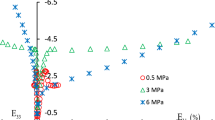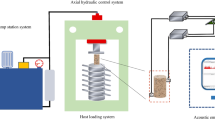Abstract
The occurrence of various types of disasters in deep underground engineering is related not only to the strength of the rock mass but also to the crack propagation capacity (CPC) under corresponding stress conditions. The deep-seated rock mass is generally in the stress state of σ1 > σ2 > σ3, and the CPC under differential stress is very important to evaluate the brittle failure of rock. Therefore, based on the deformation characteristics of Baihetan (BHT) basalt under true triaxial compression (TTC), the evaluation index (IP) of the CPC is established, which considers the characteristics of stress-induced deformation anisotropy and the propagation angle of volumetric strain. The evaluation indexes of JP marble, BS granite and BHT basalt under TTC are analysed and compared. When the stress exceeds the crack initiation stress, the evaluation index of the CPC decreases with the increase of σ2, but increases with the increase of σ3, and the effect of σ3 on the CPC index is greater than that of σ2. Under TTC, the CPC of JP marble is the largest, followed by that of BS granite and BHT basalt. The analysis shows that the evaluation index (IP) proposed in this study is also suitable for conventional triaxial compression and uniaxial compression conditions. In addition, the test result shows that there is divisibility between the failure mode and IP under TTC. The relationship between IP and the failure mode of BHT basalt shows that splitting failure occurs when IP < 0.3, that shear failure occurs when IP > 0.4, and mixed failure occurs when IP is between these values. The evaluation index of the CPC proposed in this paper can provide a theoretical reference for evaluating the failure of surrounding rock near the opening boundary of deep underground rock engineering.

















Similar content being viewed by others
References
Alejano LR, Alonso E (2005) Considerations of the dilatancy angle in rocks and rock masses. Int J Rock Mech Min Sci 42(4):481–507
Béuelle P, Desrues J, Raynaud S (2000) Experimental characterisation of the localisation phenomenon inside a Vosges sandstone in a triaxial cell. Int J Rock Mech Min Sci 37(8):1223–1237
Bieniawski ZT (1967) Mechanism of brittle fracture of rock, parts I, II and III. Int J Rock Mech Min Sci Geomech Abstr 4(4):395–430
Brace WF, Paulding BW, Scholz C (1966) Dilatancy in the fracture of crystalline rocks. J Geophys Res 71(16):3939–3953
Chang C, Haimson B (2005) Non-dilatant deformation and failure mechanism in two Long Valley Caldera rocks under true triaxial compression. Int J Rock Mech Min Sci 42(3):402–414
Detournay E (1986) Elastoplastic model of a deep tunnel for a rock with variable dilatancy. Rock Mech Rock Eng 19(2):99–108
Eberhardt E, Stead D, Stimpson B, Read RS (1998) Identifying crack initiation and propagation thresholds in brittle rock. Can Geotech J 35(2):222–233
Elliott GM, Brown ET (1985) Yield of a soft, high porosity rock. Geo Technique 35(4):413–423
Escartín J, Hirth G, Evans B (1997) Nondilatant brittle deformation of serpentinites: implications for Mohr-Coulomb theory and the strength of faults. J Geophys Res Sol Earth 102(B2):2897–2913
Fang Z, Harrison JP (2001) A mechanical degradation index for rock. Int J Rock Mech Min Sci 38(8):1193–1199
Feng XT, Zhang XW, Kong R, Wang G (2016) A novel Mogi type true triaxial testing apparatus and its use to obtain complete stress–strain curves of hard rocks. Rock Mech Rock Eng 49(5):1649–1662
Feng XT, Kong R, Zhang XW, Yang CX (2019a) Experimental study of failure differences in hard rock under true triaxial compression. Rock Mech Rock Eng 52:2109–2122
Feng XT, Zhao J, Wang ZF, Yang CX, Han Q, Zheng Z (2021) Effect of high differential stress and mineral properties on deformation and failure mechanism of hard rocks. Can Geotech J 58:411–426
Feng XT, Kong R, Zhang XW, Yang CX (2019b) Experimental study of failure differences in hard rock under true triaxial compression. Rock Mech Rock Eng. https://doi.org/10.1177/10567895211020799
Feng XT, Kong R, Yang CX, Zhang XW, Wang ZF, Han Q, Wang G (2019c) A three-dimensional failure criterion for hard rocks under true triaxial compression. Rock Mech Rock Eng 53(12):103–111
Gao YH, Feng XT, Zhang XW, Feng GL, Jiang Q, Qiu SL (2018) Characteristic stress levels and brittle fracturing of hard rocks subjected to true triaxial compression with low minimum principal stress. Rock Mech Rock Eng 51:3681–3697
Lajtai EZ, Lajtai VN (1974) The evolution of brittle fracture in rocks. J Geol Soc Lond 130(1):1–16
Martin CD, Chandler NA (1994) The progressive fracture of Lac du Bonnet granite. Int J Rock Mech Min Sci Geomech Abst 31(6):643–659
Nemat-Nasser S, Obata M (1988) A microcrack model of dilatancy in brittle materials. J Appl Mech 55(1):24–35
Peach CJ, Spiers CJ (1996) Influence of crystal plastic deformation on dilatancy and permeability development in synthetic salt rock. Tectonophysics 256(1–4):101–128
Schock RN, Heard HC, Stephens DR (1973) Stress-strain behaviour of a granodiorite and two graywackes on compression to 20 kilobars. J Geophys Res 78(26):5922–5941
Scholz CH (1968) Microfracturing and the inelastic deformation of rock in compression. J Geophys Res 73(4):1417–1432
Takahashi M, Koide H (1989) Effect of the intermediate principal stress on strength and deformation behavior of sedimentary rocks at the depth shallower than 2000 m. In: International symposium on rock at great depth, pp 19–26
Yuan SC, Harrison JP (2004) An empirical dilatancy index for the dilatant deformation of rock. Int J Rock Mech Min Sci 41(4):679–686
Zhang Y, Feng XT, Zhang XW, Wang ZF, Mostafa S, Yang CX (2019) A novel application of strain energy for fracturing process analysis of hard rock under true triaxial compression. Rock Mech Rock Eng 52(11):4257–4272
Zhang Y, Feng XT, Yang CX, Han Q, Wang ZF, Kong R (2021) Evaluation method of rock brittleness under true triaxial stress states based on pre-peak deformation characteristic and post-peak energy evolution. Rock Mech Rock Eng 54:1277–1291
Zhao XG, Cai M (2010) A mobilized dilation angle model for rocks. Int J Rock Mech Min Sci 47(3):368–384
Zhao J, Feng XT, Zhang XW, Zhang Y, Zhou YY, Yang CX (2018) Brittle-ductile transition and failure mechanism of Jinping marble under true triaxial compression. Eng Geol 232:160–170
Zoback MD, Byerlee JD (1975) The effect of cyclic differential stress on dilatancy in westerly granite under uniaxial and triaxial conditions. J Geophys Res 80(11):1526–1530
Acknowledgements
The authors sincerely acknowledge the financial support from the National Natural Science Foundation of China under Grant No. 51839003, the 111 Project under Grant No. B17009 and the Liao Ning Revitalization Talents Program under Grant No. XLYC1801002. The authors are grateful to Prof. Xiwei Zhang, Mr. Zhaofeng Wang, Mr. Yaohui Gao, Mr. Hong Xu, Mr. Zhi Zheng, Mr. Gang Wang, Mr. Liangjie Gu, Ms. Xinyue Wang and for their great assistance. The authors would also like to thank the journal editors and anonymous reviewers for their valuable suggestions.
Author information
Authors and Affiliations
Corresponding author
Ethics declarations
Conflict of Interest
The authors declare that they have no conflict of interests.
Additional information
Publisher's Note
Springer Nature remains neutral with regard to jurisdictional claims in published maps and institutional affiliations.
Rights and permissions
About this article
Cite this article
Han, Q., Feng, XT., Yang, C. et al. Evaluation of the Crack Propagation Capacity of Hard Rock Based on Stress-Induced Deformation Anisotropy and the Propagation Angle of Volumetric Strain. Rock Mech Rock Eng 54, 6585–6603 (2021). https://doi.org/10.1007/s00603-021-02623-8
Received:
Accepted:
Published:
Issue Date:
DOI: https://doi.org/10.1007/s00603-021-02623-8




